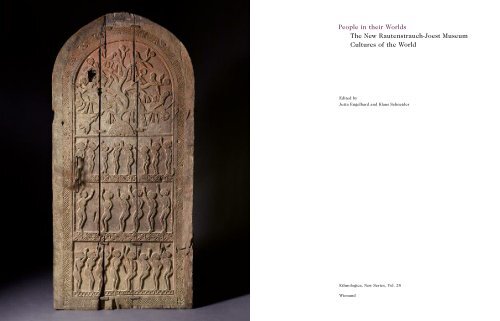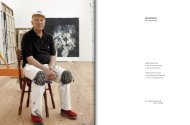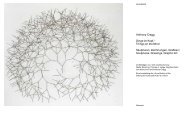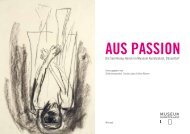People in their Worlds The New Rautenstrauch-Joest Museum ...
People in their Worlds The New Rautenstrauch-Joest Museum ...
People in their Worlds The New Rautenstrauch-Joest Museum ...
You also want an ePaper? Increase the reach of your titles
YUMPU automatically turns print PDFs into web optimized ePapers that Google loves.
<strong>People</strong> <strong>in</strong> <strong>their</strong> <strong>Worlds</strong><br />
<strong>The</strong> <strong>New</strong> <strong>Rautenstrauch</strong>-<strong>Joest</strong> <strong>Museum</strong><br />
Cultures of the World<br />
Edited by<br />
Jutta Engelhard and Klaus Schneider<br />
Ethnologica, <strong>New</strong> Series, Vol. 28<br />
Wienand
Contents<br />
Greet<strong>in</strong>g 6<br />
Foreword 8<br />
<strong>The</strong> <strong>New</strong> <strong>Rautenstrauch</strong>-<strong>Joest</strong> <strong>Museum</strong>: Cultures of the World 10<br />
<strong>The</strong> Hallmark Exhibit of the <strong>New</strong> <strong>Museum</strong>: Rice Barn: 16<br />
Creat<strong>in</strong>g the Right Mood: Music 22<br />
Introduction 24 / Gamelan 27 / Shadow Plays 30 / Dance <strong>The</strong>atre 33<br />
Encounter and Appropriation: Cross<strong>in</strong>g Borders 34<br />
Introduction 36 / Wilhelm <strong>Joest</strong>: World Traveller, Collector, Ethnographer 41 /<br />
Max von Oppenheim: Explorer, Collector, Diplomat 48<br />
<strong>The</strong> Distorted View: Prejudices 58<br />
Introduction 60 / … rural? 63 / … servile? 64 / … <strong>in</strong> need of help? 65 /<br />
… childlike? 66 / … cannibalistic? 67<br />
<strong>The</strong> World <strong>in</strong> a Showcase: <strong>Museum</strong> 68<br />
Introduction 70 / <strong>The</strong> Ethnographic Object: Collect<strong>in</strong>g and Preserv<strong>in</strong>g 76 /<br />
<strong>The</strong> Ethnographic Object: Reception and Interpretation 80<br />
A Matter of Perception and Op<strong>in</strong>ion: Art 82<br />
Introduction 84 / <strong>The</strong> Human Figure 88<br />
Liv<strong>in</strong>g Spaces – Ways of Liv<strong>in</strong>g: Liv<strong>in</strong>g Places 116<br />
Introduction 118 / Turkey – Welcom<strong>in</strong>g Guests 122 / Pla<strong>in</strong>s – Several<br />
Generations Liv<strong>in</strong>g Together 126 /Tuareg – Life <strong>in</strong> a Barren Environment 130 /<br />
Asmat – Men and Women <strong>in</strong> the Community 134<br />
<strong>The</strong> Body as a Stage: Cloth<strong>in</strong>g and Adornment 138<br />
Introduction 140 / Orig<strong>in</strong>s and Home 146 / Male and Female 150 /<br />
Life Cycle – Wedd<strong>in</strong>g 154 / Descent and Family 158 / Power and Wealth 162 /<br />
Magic and Religion 170 / War and Head-Hunt<strong>in</strong>g 174<br />
<strong>The</strong> Staged Farewell: Death and the Afterlife 180<br />
Introduction 182 / Funeral Rites – Entombment <strong>in</strong> Tana Toraja, South<br />
Sulawesi 186 / – Cremation of the Dead on Bali 192 / – Re-burial of Bones<br />
among the Ngaju-Dayak, Borneo 198 / Cont<strong>in</strong>uation of Life – Grave Goods<br />
form Peru 204 / Exert<strong>in</strong>g Influence – Ancestor Worship <strong>in</strong> Indonesia and<br />
Nigeria 208 / Honour<strong>in</strong>g the Dead – Honur<strong>in</strong>g the Dead <strong>in</strong> <strong>New</strong> Ireland 214 /<br />
Remembrance – <strong>The</strong> Festival of the Dead <strong>in</strong> Mexico 218<br />
Diversity of Belief: Religions 220<br />
Introduction 222 / Buddhism 226 / Representations of the Buddha 228 /<br />
Bodhisattvas 232 / Buddhist Laity and Monastic Communities 234 /<br />
H<strong>in</strong>duism 236 / Shiva 238 / Vishnu 242 / <strong>The</strong> ‘Great Goddess’ 246<br />
Intermediary <strong>Worlds</strong>: Rituals 250<br />
Introduction 252 / Diversity of Masks 256 / Com<strong>in</strong>g of Age – Initiation Rites<br />
of the Uramot-Ba<strong>in</strong><strong>in</strong>g on <strong>New</strong> Brita<strong>in</strong> 272 / For Women and Fields – Fertility<br />
Rites of the Bwaba, Burk<strong>in</strong>a Faso 274 / Illness and Demons – Heal<strong>in</strong>g Rituals<br />
<strong>in</strong> Sri Lanka 278 / Balanc<strong>in</strong>g Good and Evil – Barong and Rangda on Bali 280<br />
Annotations 284<br />
List of Authors 286<br />
Photo- and Copyrights 287
Hallmark Exhibit of the <strong>New</strong> <strong>Museum</strong><br />
Rice Barn<br />
<strong>The</strong> hallmark exhibit of the new <strong>Rautenstrauch</strong>-<strong>Joest</strong><br />
<strong>Museum</strong> is the largest exhibit <strong>in</strong> the collection: a magnificently<br />
decorated traditional rice barn from the Indonesian<br />
island of Sulawesi. With its wide project<strong>in</strong>g roof, the barn,<br />
constructed without the use of a s<strong>in</strong>gle nail, is an impressive<br />
testimony to the traditional architecture and craftsmanship<br />
of the Sa’dan Toraja.<br />
In the villages of the Toraja, the dwell<strong>in</strong>g house and rice barn form a unit – the<br />
house, known as ‘mother’, is private <strong>in</strong> character, while the platform of the<br />
barn, known as ‘father’, is the place where people meet to work together, celebrate<br />
and rest. Here too, guests are received and given food and dr<strong>in</strong>k, newborn<br />
children are officially welcomed <strong>in</strong>to society, and the deceased are bid farewell.<br />
<strong>The</strong> house and barn together form the social and religious centre of the family<br />
unit known as rapu. <strong>The</strong> number, size and decor of the build<strong>in</strong>gs <strong>in</strong>dicate the<br />
wealth, status and traditional world view of the community. Opulent carv<strong>in</strong>gs<br />
and colourful pa<strong>in</strong>t<strong>in</strong>g are the privilege of high-rank<strong>in</strong>g families.<br />
Leisure time <strong>in</strong> the shade of the rice barn<br />
Gantiri, Tana Toraja, Indonesia,<br />
Southeast Asia, 2007<br />
18<br />
19<br />
Rice barn alang sembang<br />
Pantanakan Lolo, Kesu’ region, Sa’dan Toraja,<br />
South Sulawesi, Indonesia, Southeast Asia, c. 1935<br />
Wood, pa<strong>in</strong>t, bamboo, rattan; h. 750 cm<br />
Carved by Ne’Kambane<br />
Restored by the Kalker Werkstätten, Cologne<br />
with generous f<strong>in</strong>ancial support from the Kölner<br />
Kulturstiftung der Kreissparkasse Köln<br />
RJM 56000<br />
<strong>The</strong> rice barn of the <strong>Rautenstrauch</strong>-<strong>Joest</strong> <strong>Museum</strong><br />
before it was dismantled<br />
Tana Toraja, South Sulawesi, Indonesia,<br />
Southeast Asia, 1983
Max von Oppenheim<br />
Explorer, Collector, Diplomat<br />
<strong>The</strong> varied life’s work of Max Freiherr von Oppenheim, who was born <strong>in</strong><br />
Cologne <strong>in</strong> 1860, is characterised by his all-dom<strong>in</strong>ant fasc<strong>in</strong>ation with<br />
the Orient. What was then the Ottoman Empire was for many years at the<br />
centre of his life, research and activities. He spent the second half of his<br />
life ma<strong>in</strong>ly <strong>in</strong> Berl<strong>in</strong> edit<strong>in</strong>g his scientific work.<br />
Instead of go<strong>in</strong>g <strong>in</strong>to his father’s bank after tak<strong>in</strong>g his doctoral degree <strong>in</strong> law,<br />
Oppenheim spent more than 15 years <strong>in</strong> the Near East. Alongside his activities<br />
as a correspondent at the German Consulate General <strong>in</strong> Cairo from 1896<br />
onwards, Oppenheim, who spoke perfect Arabic, devoted himself to the study<br />
of the Bedou<strong>in</strong>s and archaeology. He used his knowledge and contacts <strong>in</strong> the<br />
First World War to agitate on behalf of Kaiser Wilhelm among the Arab population<br />
aga<strong>in</strong>st Brita<strong>in</strong> and France. In Berl<strong>in</strong> he founded the propaganda <strong>in</strong>stitute<br />
“Intelligence Agency for the Orient”. In the 1920s he created a large oriental<br />
library, a research <strong>in</strong>stitute and a museum for his excavation f<strong>in</strong>ds from Tell<br />
Halaf. Oppenheim died <strong>in</strong> 1946 <strong>in</strong> Landshut.<br />
Max von Oppenheim<br />
Room <strong>in</strong> Oppenheim’s house <strong>in</strong> Cairo<br />
c. 1900<br />
48<br />
49<br />
Max von Oppenheim <strong>in</strong> the Orient – Diplomat, Collector, Explorer<br />
In 1896 at the age of 36 Oppenheim was appo<strong>in</strong>ted attaché to the German Consulate<br />
General <strong>in</strong> Cairo. It was his task to report to Berl<strong>in</strong> on the Muslim Arab<br />
world. In the 13 years of his accreditation, Oppenheim wrote over 500 reports<br />
and memoranda. As a result of his numerous journeys and multitude of contacts<br />
to <strong>in</strong>fluential local politicians and dignitaries, he was on a number of occasions<br />
suspected of act<strong>in</strong>g as a spy by several European diplomats.<br />
In Cairo Oppenheim led an enigmatic double life. In his professional life he<br />
moved <strong>in</strong> western circles, privately, however, he lived like an Arab and even had<br />
his own harem. His house reflected his life on the boundaries between cultures.<br />
Apart from European furniture, it conta<strong>in</strong>ed a constantly grow<strong>in</strong>g collection of<br />
Ch<strong>in</strong>ese and European porcela<strong>in</strong>, oriental weapons, furniture, metal objects,<br />
Islamic measur<strong>in</strong>g <strong>in</strong>struments, marquetry work, pictures, manuscripts, jewellery<br />
and textiles. At Oppenheim’s legendary soirées <strong>in</strong> the style of the ‘Arabian<br />
Nights’, guests dressed frequently <strong>in</strong> his splendid Ottoman robes. On<br />
Oppenheim’s return to Berl<strong>in</strong> his collection comprised several thousand<br />
objects.<br />
In his memoirs, which he later wrote <strong>in</strong> Berl<strong>in</strong>, he described his time <strong>in</strong> the Orient<br />
<strong>in</strong> the follow<strong>in</strong>g words:<br />
“… a wonderful time. 13 years <strong>in</strong> the dream country of Egypt, a dream life<br />
last<strong>in</strong>g 13 years, on the one hand <strong>in</strong> <strong>in</strong>ternational diplomacy, on the other<br />
with<strong>in</strong> the local world, which I understood and which understood me.” 14<br />
Oppenheim’s <strong>in</strong>terest <strong>in</strong> the Bedou<strong>in</strong>s rested on a meet<strong>in</strong>g with Faris Pasha, a<br />
sheikh of the Shammar Bedou<strong>in</strong>s, whose hospitality Oppenheim enjoyed for<br />
several days <strong>in</strong> 1893 dur<strong>in</strong>g an expedition from the Mediterranean to the<br />
Persian Gulf. A fraternal bond <strong>in</strong> writ<strong>in</strong>g with this <strong>in</strong>fluential leader enabled<br />
Oppenheim <strong>in</strong> subsequent years to make contact with other Bedou<strong>in</strong> groups<br />
whose way of life and attitudes he admired and whom he wished to understand<br />
better. He noted down the nomadic movements and k<strong>in</strong>ship relations of more<br />
than 240 tribes and sub-groups with meticulous accuracy. His photographic<br />
documentation with photographs of his own and photographs bought from<br />
other photographers is also extensive. His complex f<strong>in</strong>d<strong>in</strong>gs were published<br />
Cross<strong>in</strong>g Borders
<strong>The</strong> Distorted View<br />
Prejudices<br />
Prejudices, stereotypes and clichés are a worldwide<br />
phenomenon. <strong>The</strong>y serve among other th<strong>in</strong>gs to <strong>in</strong>tegrate<br />
the ‘unknown’ <strong>in</strong>to one's own world view, to reduce fear<br />
and to def<strong>in</strong>e and dissociate oneself from the ‘other’.<br />
In 1962 Federal President He<strong>in</strong>rich Lübke is said to have greeted people wait<strong>in</strong>g<br />
for him <strong>in</strong> Liberia with the words, “Ladies and Gentlemen, dear Negroes”.<br />
This is now thought to be an urban legend. However, people agree that words of<br />
this k<strong>in</strong>d might have been expected from him consider<strong>in</strong>g that <strong>in</strong> 1966 on<br />
another state visit to Madagascar, he said “<strong>People</strong> must also learn to be clean.” 1<br />
That was a long time ago, people might object, but if one looks at how Africa<br />
and its peoples are represented <strong>in</strong> everyday culture today, one still f<strong>in</strong>ds the old<br />
prejudices. No cont<strong>in</strong>ent is still characterised <strong>in</strong> such a stereotypical and<br />
clichéd way as the African cont<strong>in</strong>ent.<br />
Prejudices, stereotypes and clichés are present worldwide. It is problematic,<br />
however, when unequal power relationships are manifested <strong>in</strong> prejudices. Thus<br />
Africa is never presented as equal to Europe, but as morally, technologically and<br />
culturally <strong>in</strong>ferior. Africa, the ‘black’, the ‘dark’ cont<strong>in</strong>ent represents the prototypical<br />
other, which exerts a certa<strong>in</strong> attraction but which also arouses fear. This<br />
is underl<strong>in</strong>ed by the use of a certa<strong>in</strong> term<strong>in</strong>ology. When people speak or write<br />
about Africa they often use words such as ‘natives’ and ‘tribes’ <strong>in</strong>stead of<br />
‘<strong>in</strong>digenous population’ or ‘nations’, which are used automatically <strong>in</strong> reference<br />
to other parts of the world.<br />
Some people claim that they do not know that these words are derogatory<br />
or <strong>in</strong>sist that they do not mean them <strong>in</strong> a racist sense. <strong>The</strong>se words all have a<br />
history, though, <strong>in</strong> which ‘tribes’ and ‘natives’ quite <strong>in</strong>tentionally po<strong>in</strong>t to the<br />
alleged primitive and uncivilised nature of African peoples. When people speak<br />
of ‘tribal conflict’ <strong>in</strong>stead of civil war, they still <strong>in</strong>tend to underl<strong>in</strong>e that this has<br />
noth<strong>in</strong>g to do with serious political conflict. Our language is <strong>in</strong>separably l<strong>in</strong>ked<br />
with our th<strong>in</strong>k<strong>in</strong>g and actions and thus has a direct bear<strong>in</strong>g on our behaviour<br />
towards people of African orig<strong>in</strong>, who, especially recently, have <strong>in</strong>creas<strong>in</strong>gly<br />
been the victims of racist violence.<br />
Modern genetics has refuted the division of humanity <strong>in</strong>to ‘races’. On a<br />
genetic level two people from different cont<strong>in</strong>ents may be more similar than<br />
<strong>in</strong>dividuals from a specific group with, say, the same sk<strong>in</strong> colour. ‘Races’ are an<br />
<strong>in</strong>vention of the late 18th and 19th century, based on the idea of a fundamental<br />
<strong>in</strong>equality between peoples. Humanity was categorised hierarchically <strong>in</strong>to<br />
Cartoon, Matthias Kiefel, 2007.<br />
“I’m French. That’s why I’m wear<strong>in</strong>g<br />
a beret.” – “I’ve got sauerkraut on my<br />
head. Guess where I come from.”<br />
Postcard, Cameroon Exhibition, 1906<br />
<strong>Museum</strong> für Völkerkunde Frankfurt, Germany<br />
<strong>The</strong> collections of German anthropology<br />
museums conta<strong>in</strong> a disproportionate<br />
amount of weapons, usually collected<br />
dur<strong>in</strong>g the colonial period. Presented<br />
<strong>in</strong> a fan-shaped arrangement, they<br />
encouraged the cliché of the ‘wild’<br />
African.<br />
60<br />
Liebig collector cards<br />
Series 387, Card 12, 1898<br />
Series 449, Card 9, 1900<br />
At the end of the 19 th century collector<br />
cards contributed to the dissem<strong>in</strong>ation<br />
of romantic clichés about ‘peoples’ and<br />
‘races’. In a subtle way they supported<br />
the idea of a hierarchical division of<br />
humanity.<br />
61<br />
‘lower’ or ‘primitive’ and ‘highly developed’ or ‘master races’. <strong>The</strong> white European<br />
was at the head of this hierarchy. In the context of the transatlantic slave<br />
trade and colonialism, Europe <strong>in</strong>vented its ‘uncivilised, primitive other’ which<br />
it could choose to ‘save’ or destroy. This construct led to the fact that colonialism<br />
was supported by the majority of people <strong>in</strong> Europe. Dissem<strong>in</strong>ated via the<br />
media, politics, culture, the educational system and language, and supported by<br />
a lack of public engagement with colonial history, this discourse cont<strong>in</strong>ues to<br />
be dom<strong>in</strong>ant to the present day.<br />
Specific cultural characteristics cont<strong>in</strong>ue to be attributed arbitrarily to biological<br />
differences such as sk<strong>in</strong> colour. Such racist th<strong>in</strong>k<strong>in</strong>g devalues people on<br />
the basis of external characteristics. ‘Race’ as a category is still important <strong>in</strong> a<br />
political, cultural and social context. White people rarely reflect on the colour<br />
of <strong>their</strong> sk<strong>in</strong> as they believe that whiteness is the normal th<strong>in</strong>g and anyth<strong>in</strong>g else<br />
an aberration. Nevertheless, whiteness is also a racist construct. Although<br />
whiteness only ga<strong>in</strong>s def<strong>in</strong>ition <strong>in</strong> contrast to blackness, ‘race’ is associated<br />
widely only with blackness <strong>in</strong> contexts where whites are <strong>in</strong> a majority, as though<br />
whites had neither ‘race’ nor colour. S<strong>in</strong>ce the <strong>in</strong>vention of ‘races’, <strong>in</strong> this country<br />
whites have positioned themselves outside this category <strong>in</strong> order to study<br />
and dom<strong>in</strong>ate the other from this outside perspective. When whites speak about<br />
<strong>their</strong> own identity, they usually mention aspects such as profession, age, sex,<br />
and religion without mention<strong>in</strong>g that they are white. <strong>The</strong>y are conv<strong>in</strong>ced that<br />
the colour of <strong>their</strong> sk<strong>in</strong> says noth<strong>in</strong>g about them. When characteris<strong>in</strong>g people<br />
of African orig<strong>in</strong> they give pride of place to sk<strong>in</strong> colour.<br />
<strong>The</strong> categorisation and judgement of people on the basis of <strong>their</strong> sk<strong>in</strong> colour<br />
has its counterpart <strong>in</strong> the total denial of such differences. This denial is also<br />
called ‘colour bl<strong>in</strong>dness’. <strong>The</strong> <strong>in</strong>tention is to underm<strong>in</strong>e racist patterns of perception<br />
and the positive emphasis on whiteness. Such people refuse to perceive<br />
people via sk<strong>in</strong> colour. Statements such as “All people are equal” or “I consider<br />
my white sk<strong>in</strong> to be unimportant” are perhaps evidence of good <strong>in</strong>tentions. This<br />
‘colour bl<strong>in</strong>dness’, however, leads to the fact that the discrim<strong>in</strong>ation actually<br />
experienced by people of African orig<strong>in</strong> is not taken seriously or is dismissed<br />
as an <strong>in</strong>dividual case.
<strong>The</strong>re are also stereotypes that are supposedly positive. When for <strong>in</strong>stance it is<br />
claimed that Africans are fast runners, good at play<strong>in</strong>g the drums and are good<br />
dancers, these can be seen at first glance as positive attributes. But people of<br />
African orig<strong>in</strong> rightly resist be<strong>in</strong>g stereotyped <strong>in</strong> this way, with <strong>their</strong> abilities<br />
be<strong>in</strong>g restricted to seem<strong>in</strong>gly ‘natural’ body-oriented activities.<br />
White people are rarely aware of <strong>their</strong> privileged position. When they look<br />
for work or for a flat or <strong>in</strong> <strong>their</strong> contacts with officialdom they expect to be<br />
treated with respect; they do not have to deal with racism if they do not want<br />
to. <strong>The</strong> situation is quite different for people of African orig<strong>in</strong>. <strong>The</strong>y are confronted<br />
day <strong>in</strong> and day out with racism and are forced to come to terms with it.<br />
This affects black Germans <strong>in</strong> a specific way, as every day they are made out to<br />
be the ‘stranger’ or the ‘other’ as a result of <strong>their</strong> sk<strong>in</strong> colour. <strong>The</strong>y are confronted<br />
with comments such as “Your German is really good!” or they are asked<br />
which country they come from. Be<strong>in</strong>g German is still implicitly equated with<br />
be<strong>in</strong>g white. ‘Other<strong>in</strong>g’ people can also turn <strong>in</strong>to violence. <strong>The</strong>re are frequently<br />
racist assaults whereby people are <strong>in</strong>jured or even murdered. Even if these acts<br />
of extreme violence are presented as exceptions to the rule, everyday racism is<br />
still expressed <strong>in</strong> many areas of life.<br />
As long as the images of Africa constructed dur<strong>in</strong>g the colonial period survive,<br />
noth<strong>in</strong>g much will change <strong>in</strong> people’s attitudes. Latent or even overt<br />
racism aga<strong>in</strong>st people of African orig<strong>in</strong> will not disappear, either.<br />
Cartoon, Tom, 2002<br />
“Go back to where you came from!” –<br />
“What should I do <strong>in</strong> Dortmund?”<br />
62<br />
… rural?<br />
At the end of the 19th century colonial appropriation was partly justified by the alleged backwardness of the African cont<strong>in</strong>ent.<br />
<strong>The</strong> village of straw-covered huts was represented as the typical type of African settlement. From early on, African<br />
straw-hut villages decorated objects of everyday German culture. Little has changed to this day. ‘Folklore’ dom<strong>in</strong>ates the<br />
representation of Africa – you can make your own ‘authentic’ African village with a present-day booklet of stickers which<br />
hardly differs from its t<strong>in</strong> predecessors of around a hundred years ago. Now, as <strong>in</strong> the past, the objects do not represent<br />
an actual village <strong>in</strong> a specific African country, but are the product of the imag<strong>in</strong>ation of <strong>their</strong> European creators. Modern<br />
Africa hardly features <strong>in</strong> the media, even though major cities such as Lagos or Johannesburg with <strong>their</strong> sky scrapers,<br />
traffic and populations <strong>in</strong> the millions are <strong>in</strong> no way <strong>in</strong>ferior to <strong>their</strong> European counterparts.<br />
Group of figures “African<br />
Village”<br />
Germany, 2008<br />
after a model from c. 1890<br />
T<strong>in</strong>, pigment; h. max 3 cm<br />
RJM 63885<br />
63<br />
Johannesburg, South Africa, 2004<br />
“African Village” stickers’ booklet<br />
England, 1998<br />
Prejudices
<strong>The</strong> Human Figure<br />
Figure of a deity d<strong>in</strong>onga eidu<br />
Nukuoro, Carol<strong>in</strong>e Islands, Micronesia, Oceania,<br />
19 th century<br />
Wood; h. 51 cm<br />
Acquired from C. Jeschke, Zehden/Oder, 1920<br />
RJM 34029<br />
<strong>The</strong> anthropomorphic figures from the<br />
t<strong>in</strong>y Micronesian atoll of Nukuoro are<br />
among the most impressive works of<br />
art from Oceania. Artists reduced the<br />
human body to its basic shapes. Eyes,<br />
ears and mouth are omitted and arms<br />
and legs are presented only <strong>in</strong> <strong>their</strong><br />
most rudimentary form. <strong>The</strong> shoulders<br />
are decorated with a delicately <strong>in</strong>cised<br />
pattern which corresponds to the tattoos<br />
of Nukuoro chiefta<strong>in</strong>s and <strong>their</strong> families.<br />
<strong>The</strong> sculptures represent deities and<br />
deified ancestors. <strong>The</strong>y were “wrapped<br />
<strong>in</strong> cloth”, as one European traveller<br />
noted <strong>in</strong> the second half of the 19 th<br />
century, and were kept and worshipped<br />
<strong>in</strong> cult houses or <strong>in</strong> cult places. On the<br />
occasion of a major annually recurr<strong>in</strong>g<br />
festival, the <strong>in</strong>habitants of the island,<br />
who were of Polynesian orig<strong>in</strong>, gathered<br />
around the figures, which had been<br />
specially adorned for the celebration,<br />
and offered fruit and other food as a<br />
sacrifice. <strong>The</strong>re is not much <strong>in</strong>formation<br />
on the religious context of these rare<br />
figures. <strong>The</strong> activities of Christian<br />
missionaries, who began convert<strong>in</strong>g<br />
the <strong>in</strong>habitants of Nukuoro towards<br />
the end of the 19 th century, consigned<br />
the old religious concepts and practices<br />
to oblivion.<br />
Sculptures from Africa and Oceania were<br />
a source of <strong>in</strong>spiration for expressionist<br />
and surrealist artists. <strong>The</strong> Swiss sculptor<br />
Alberto Giacometti (1901–1966) copied<br />
non-European art <strong>in</strong> pencil to “get a clear<br />
idea of what I am see<strong>in</strong>g”, as he put it. 4<br />
In an edition of the French art journal<br />
“Cahiers d’Art” from 1929, he found<br />
numerous examples of art from Oceania.<br />
A photograph of the Nukuoro figure<br />
shown here, published <strong>in</strong> the journal,<br />
was chosen as a model for one of his<br />
draw<strong>in</strong>gs.<br />
88
Malekula, Vanuatu, Melanesia, 19 Diversity of Masks Oceania<br />
th century<br />
Wood, pa<strong>in</strong>t; h. 26 cm<br />
RJM 31254<br />
Witu Islands, Papua <strong>New</strong> Gu<strong>in</strong>ea, Melanesia,<br />
c. 1900<br />
Wood, pa<strong>in</strong>t; h. 59.5 cm<br />
RJM 20767<br />
Elema, Papuan Gulf, Papua <strong>New</strong> Gu<strong>in</strong>ea,<br />
Melanesia, early 20 th century<br />
Barkcloth, cane, pa<strong>in</strong>t; h. 132.5 cm<br />
RJM 35759<br />
267<br />
Sulka, <strong>New</strong> Brita<strong>in</strong>, Papua <strong>New</strong> Gu<strong>in</strong>ea,<br />
Melanesia, early 20 th century<br />
Cane, pith, cassowary feathers; h. 73 cm<br />
Restored with funds from the State of North<br />
Rh<strong>in</strong>e-Westphalia and the City of Cologne,<br />
2008<br />
RJM 24802<br />
Northern <strong>New</strong> Ireland, Papua <strong>New</strong> Gu<strong>in</strong>ea,<br />
Melanesia, 19 th century<br />
Wood, barkcloth, plant fibre; h. 107.5 cm<br />
RJM 4442<br />
<strong>New</strong> Caledonia, Melanesia, c. 1900<br />
Wood, feathers, human hair; h. 140 cm<br />
Restored with funds from the Börner Foundation,<br />
Cologne<br />
RJM 19879<br />
Rituals
Com<strong>in</strong>g of Age –<br />
Initiation Rites of the Uramot-Ba<strong>in</strong><strong>in</strong>g<br />
on <strong>New</strong> Brita<strong>in</strong>, Melanesia<br />
<strong>The</strong> transition from child to adult is celebrated <strong>in</strong> many societies with<br />
special rituals. <strong>The</strong> <strong>in</strong>itiation ceremony marks the transition of young<br />
people to adults. Often ancestor or spirit masks appear to accompany<br />
the ritual.<br />
<strong>The</strong> Uramot-Ba<strong>in</strong><strong>in</strong>g <strong>in</strong>habit the mounta<strong>in</strong>ous region <strong>in</strong> the northeast of the<br />
Melanesian island of <strong>New</strong> Brita<strong>in</strong>. <strong>The</strong>ir livelihood depends on hunt<strong>in</strong>g and horticulture.<br />
After a phase of segregation of the young male <strong>in</strong>itiates, a spectacular<br />
nocturnal fire dance forms the climax of the <strong>in</strong>itiation rites. <strong>The</strong> masked<br />
dancers allude <strong>in</strong> <strong>their</strong> performance to spirits which may be dangerous for<br />
human be<strong>in</strong>gs. Little is known about the <strong>in</strong>itiation of girls which is also accompanied<br />
by masked dances. As <strong>in</strong> the male <strong>in</strong>itiation rites, the girls are <strong>in</strong>itiated<br />
<strong>in</strong>to the secrets of the female mask <strong>in</strong> a concealed ritual site <strong>in</strong> the bush<br />
unknown to the other sex. 3<br />
<strong>The</strong> <strong>in</strong>itiation of boys is not the only occasion for a fire dance. Nowadays it is<br />
also performed <strong>in</strong> the context of community projects, on festival days and for<br />
tourists.<br />
Nocturnal dance of the Uramot-Ba<strong>in</strong><strong>in</strong>g<br />
Gaulim, <strong>New</strong> Brita<strong>in</strong>, Oceania, 1982<br />
272<br />
Kavat mask<br />
Uramot-Ba<strong>in</strong><strong>in</strong>g, <strong>New</strong> Brita<strong>in</strong>, Oceania,<br />
20 th century<br />
Barkcloth, rattan; h. 111 cm<br />
RJM 53002<br />
273<br />
Kavat masks appear at the nocturnal<br />
fire dance of the Ba<strong>in</strong><strong>in</strong>g. After the<br />
onset of darkness, the black and white<br />
pa<strong>in</strong>ted mask wearers, adorned with tufts<br />
of leaves, appear on the dance ground.<br />
<strong>The</strong>y dance around and through the fire<br />
accompanied by song and the rhythmic<br />
pound<strong>in</strong>g of stamp<strong>in</strong>g tubes. <strong>The</strong> masks,<br />
made to the exclusion of women, are<br />
presented to the <strong>in</strong>itiates <strong>in</strong> <strong>their</strong> camp<br />
<strong>in</strong> the bush before the performance.<br />
However, they are still not permitted<br />
to wear them.<br />
Rituals
















